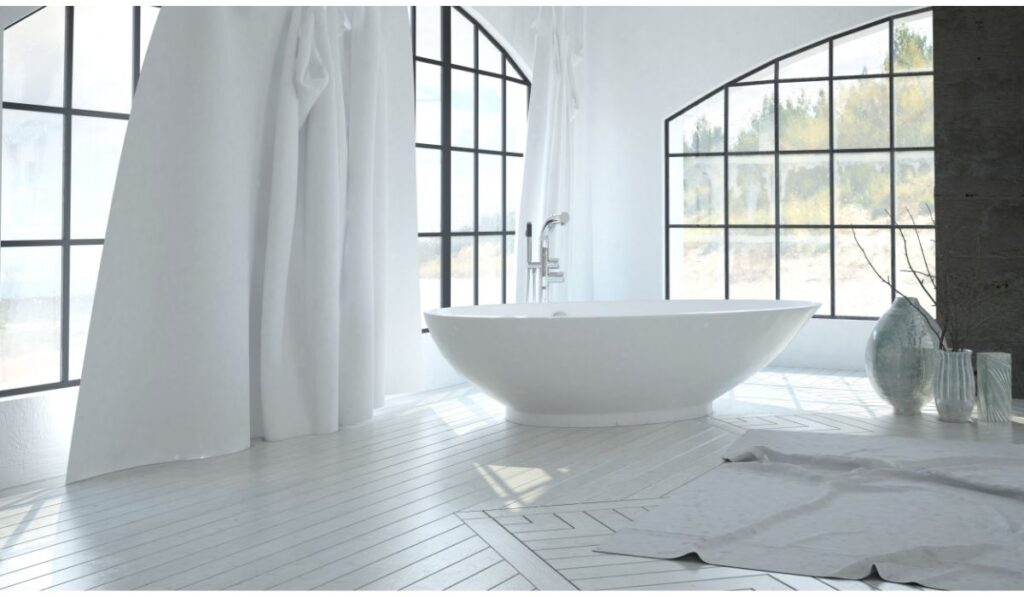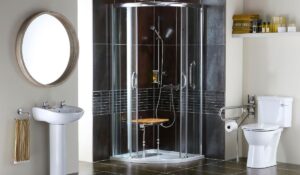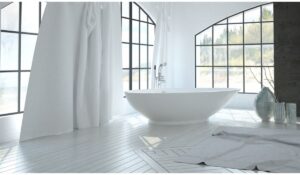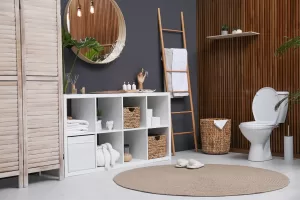Have you ever walked into a bathroom and thought, “Wow, this floor is absolutely stunning!”? That’s the power of choosing the absolute best flooring for bathrooms. But here’s the thing…
We’ve seen our fair share of bathroom renovations go awry. The wrong type of flooring can not only dampen your design but also lead to problems like water damage or slipping hazards.
This blog post will be your lifesaver. From ceramic tiles that blend durability with aesthetics, to vinyl planks offering an array of designs while resisting water – we’re diving deep into every viable option. We’ll even explore some unconventional choices like cork and bamboo that add warmth and sustainability to style!
Get ready, because by the end: you’ll be equipped to make a choice as solid as porcelain tile itself.
Ceramic and Porcelain Tile Flooring for Bathrooms
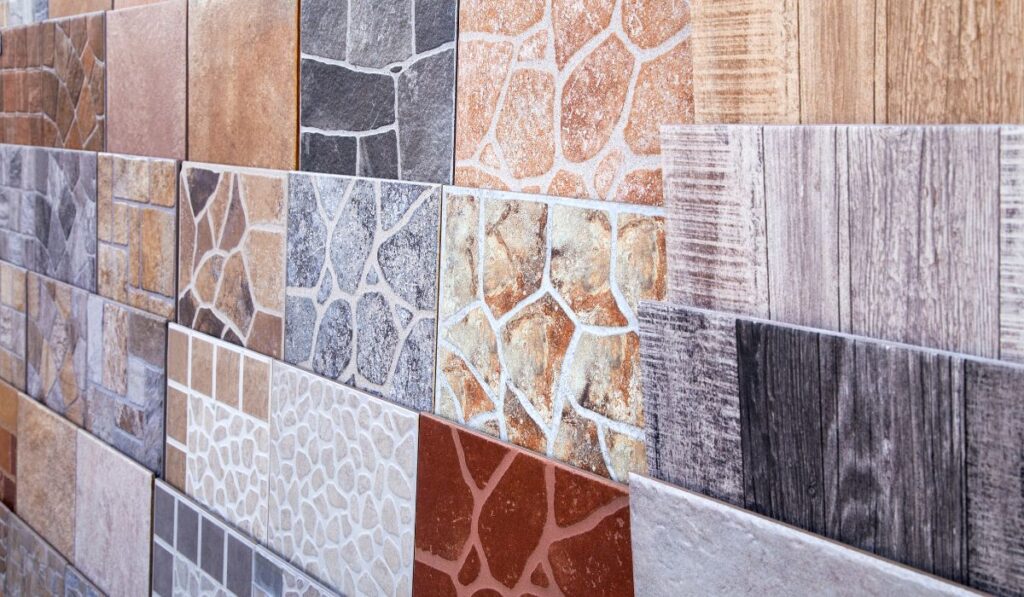
If you’re looking for a bathroom floor with durability, water resistance, and attractive appeal, ceramic or porcelain tiles are a great choice. These popular flooring options have proven their worth in standing up against heavy foot traffic without surrendering their stylish look.
Benefits of Ceramic and Porcelain Tiles
The resilience of both ceramic tiles and porcelain tiles, coupled with their waterproof nature, makes them ideal contenders for any bathroom floor. Not only do they offer practical benefits but they also come in an array of designs that can elevate the overall aesthetics of your powder room or full bath.
The best flooring for bathrooms often include these materials because they resist water seeping into sublayers – a common issue with bathrooms. The completely impervious nature protects the underlayer from potential water damage while keeping the surface easy to clean.
Choosing Between Ceramic and Porcelain Tiles
To make an informed decision between ceramic tile or porcelain tile for your floor tiles requires understanding their subtle differences. While both types are made from clay mixture fired at high temperatures, porcelain is more dense making it slightly more durable but also more expensive.
Do your kids love splashing around during bath time? Porcelain adds another layer of protection by being less porous, meaning it absorbs less moisture. It can offer peace-of-mind knowing those accidental spills won’t wreak havoc on your floors.
Vinyl Flooring – A Versatile Choice for Bathrooms
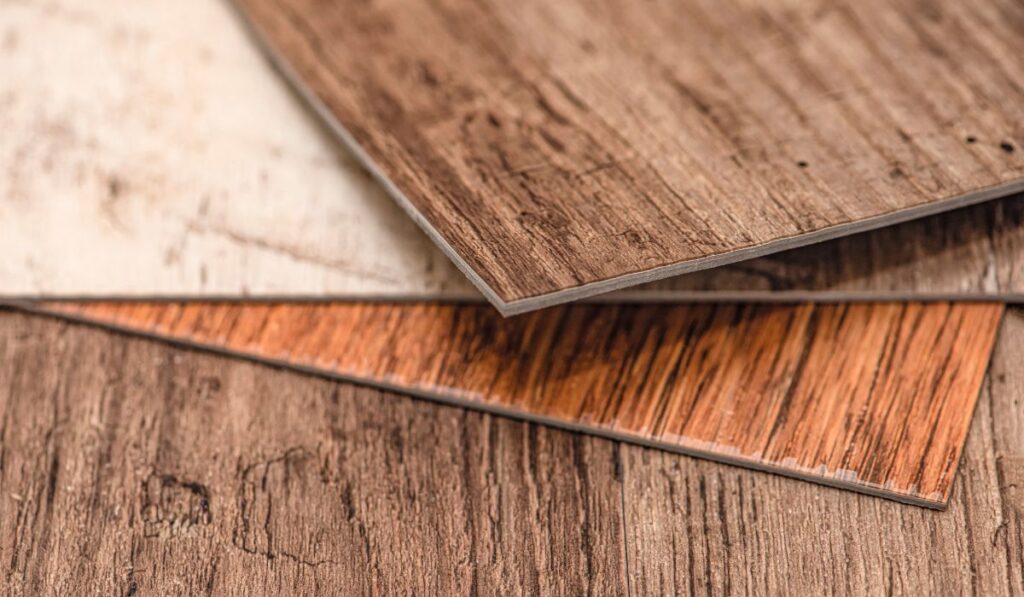
When it comes to bathroom flooring, vinyl has risen as a star player. Its water-resistant nature coupled with its easy installation process makes it a great option. From planks to tiles, the design possibilities are endless.
The Rise of Luxury Vinyl in Bathroom Design
Luxury vinyl is gaining popularity in modern bathrooms because of its striking aesthetics and functionality. With options like WPC (wood plastic composite) and SPC (stone plastic composite) vinyl on the market, you can enjoy scratch-resistant surfaces that withstand heavy foot traffic without breaking your budget.
A wide variety of designs allows homeowners to create personalized spaces while maintaining practicality. Give your Bellevue flooring experts at Belred Construction a call to understand how these different types – such as luxury vinyl plank or tile – could fit into your home’s unique style and needs.
Is Laminate Flooring Best for Bathrooms?
Laminate flooring can be a budget-friendly choice that offers the aesthetics of real wood without the high cost. Though considering the wet nature of bathrooms, laminate flooring might not be the best option.
The reason is pretty straightforward: water can cause quick damage to laminate floors. Even though modern laminates have improved in quality, they’re not completely impervious to water damage.
Water seeping into your bathroom floor could lead to unsightly warping or even worse – serious structural damage over time. The statistics aren’t in favor either; most damages caused by leaks occur on laminate bathroom floors.
Natural Stone Tile Flooring – A Touch of Elegance
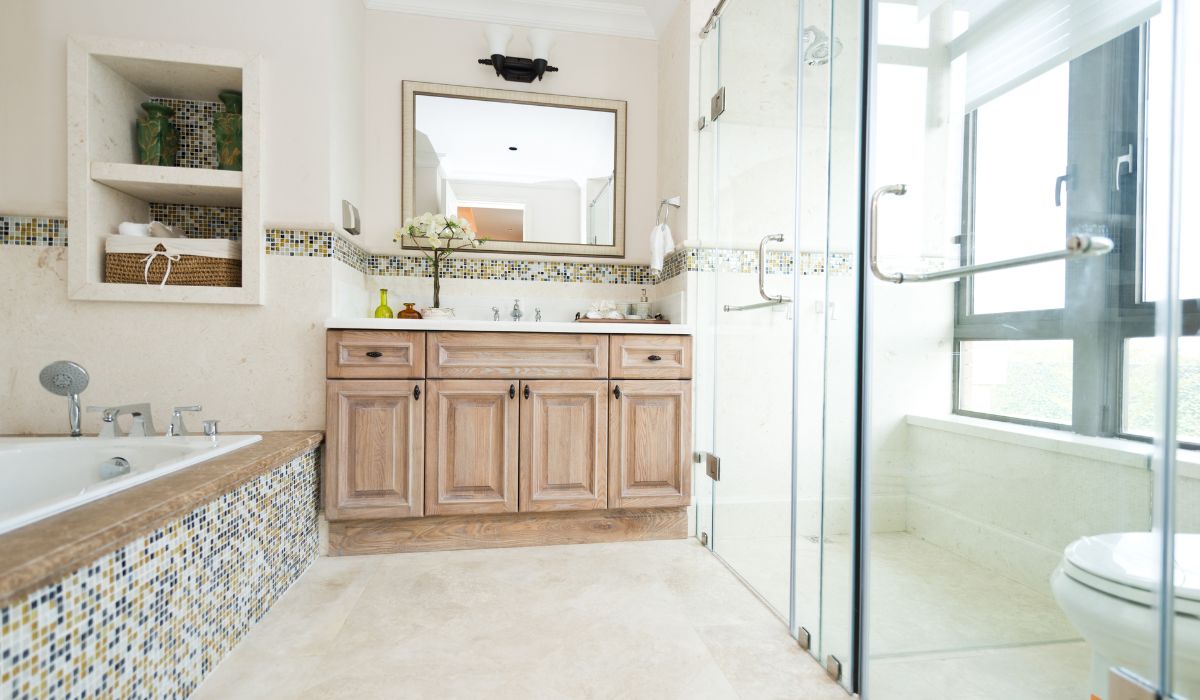
When you think about luxury and elegance in a bathroom, natural stone tile flooring often comes to mind. This flooring option brings durability with an unmatched variety of colors and patterns.
This isn’t just about aesthetics though. The durability factor is key, and with natural stone tiles, your bathroom floor can withstand the constant foot traffic without losing its appeal.
But this choice isn’t for every budget. Stone tile floors require regular maintenance to keep them looking their best over time. This means additional costs beyond the initial investment.
The charm of natural stone tile, whether marble or slate, adds style and personality to any space it graces while standing up well against water damage too.
You’ll need specific cleaning products designed for natural stones which further adds on cost but will help ensure your beautiful floor stays pristine year after year.
Cork Flooring – An Eco-friendly Option for Bathrooms
As we strive to make greener choices, cork flooring emerges as a viable option. Cork is not only an eco-friendly material but also brings uniquely beautiful features to your bathroom floor.
One of the biggest draws of cork is its natural warmth and underfoot comfort, which can be quite appealing in a room where you’re often barefoot. Plus, it adds style without sacrificing practicality – making it one of the best flooring for bathrooms.
Aesthetics aside, its water-resistant properties make it stand out among other bathroom flooring options. It’s resistant to mold, mildew, and water damage making it suitable for wet bathrooms. And it doesn’t dent or scratch easily which is a major perk.
If there are spills (it happens), standing water won’t pose much threat either due to its waterproof nature when properly sealed with a polyurethane topcoat. This way you get a real wood-like feel without worrying about potential damages from water seeping through the surface.
Bamboo Flooring – A Sustainable Choice for Bathrooms
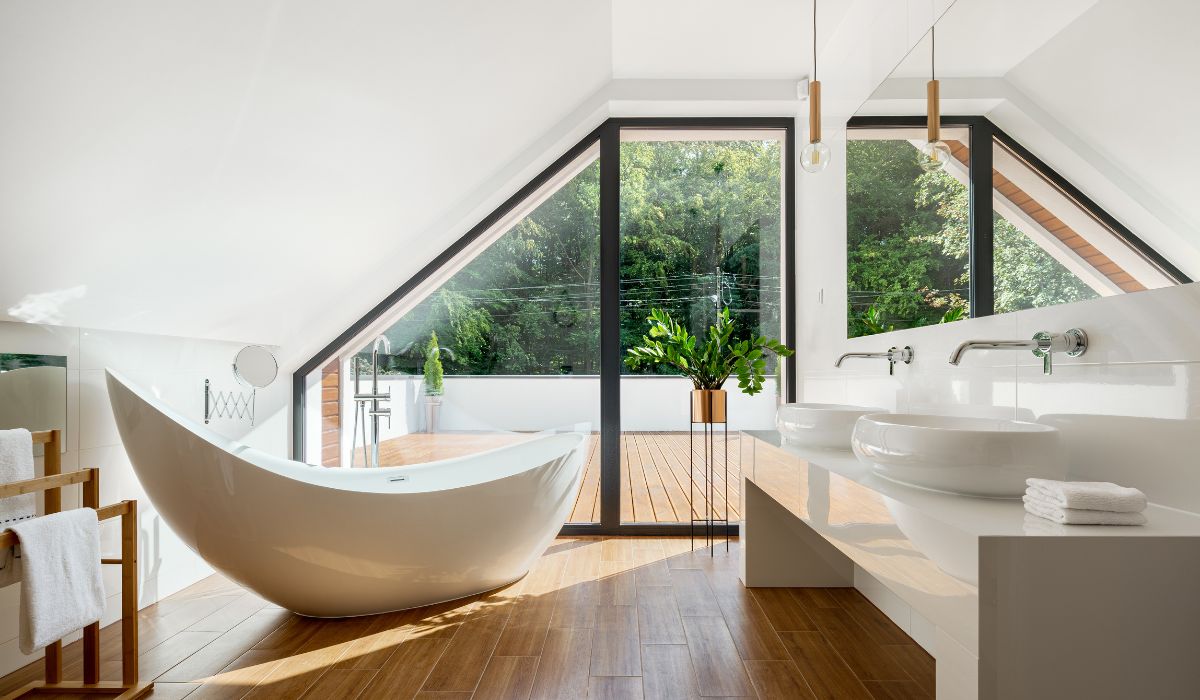
We bet you’ve never considered bamboo as a bathroom flooring option. Surprisingly, this fast-growing plant makes an excellent and sustainable choice. It’s eco-friendly, cost-effective, and with the right type like engineered bamboo, it can withstand wet environments too.
The popularity of bamboo flooring is on the rise due to its inherent properties. Bamboo is often compared to hardwood floors in terms of strength but without the deforestation guilt-trip attached.
In addition to being solid underfoot (yes even in stilettos), it has a unique aesthetic that adds style and warmth to any powder room or full bath setup. More and more people every year are selecting bamboo bathrooms in lieu of traditional wood flooring.
Stained Concrete Flooring – A Modern Alternative
For a contemporary, eye-catching bathroom flooring option, consider stained concrete. It’s durable and low-maintenance but offers high style.
The Process of Staining Concrete Floors
It’s not just about slapping some color on your concrete slab. The process involves using acid-based chemical stains that react with the minerals in the concrete to create rich, earthy tones and marbled effects.
This technique transforms an ordinary slab into something extraordinary. And each application is unique due to variations in texture and age of the concrete.
While stained concrete can make a great option for bathroom flooring ideas because of its durability and water resistance, it isn’t completely impervious to water damage if not properly sealed.
To ensure long-lasting beauty and prevent water seeping through or standing water from wreaking havoc on your beautiful new floors, proper finishing and sealing are critical. And this doesn’t need any polyurethane topcoat.
You’ll love knowing that compared to other popular flooring options like wood or tile flooring, stained concrete is relatively inexpensive—both material-wise as well as installation costs—but still adds style. It can also withstand heavy foot traffic without showing signs of wear too quickly which makes it ideal for other renovations including kitchens.
The Best Flooring for Bathrooms: Which One Is for You?
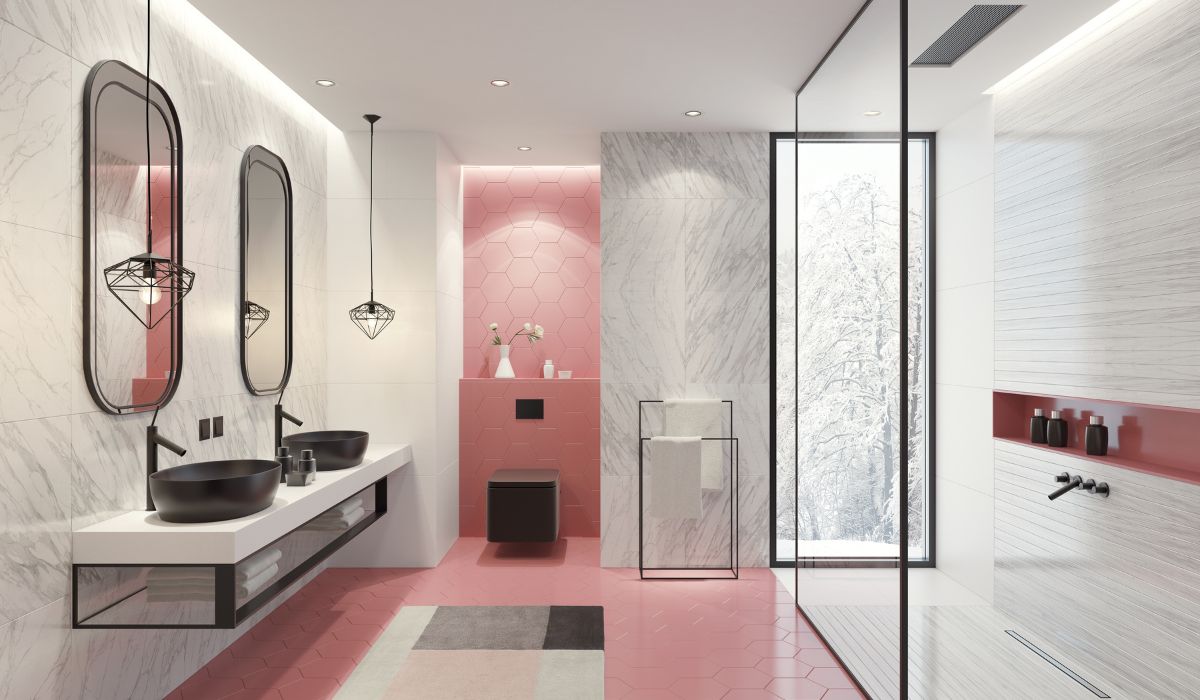
You’re no longer walking in the dark. You’ve learned that choosing the best flooring for bathrooms goes beyond aesthetics. It’s about durability and water resistance too.
Ceramic or porcelain tiles? They offer a balance of resilience and design variety. Considering vinyl? Remember it’s not just practical but also versatile with many modern designs to choose from.
Laminate flooring can be budget-friendly, but may not be the best choice for everyone due to its tendency to succumb to water damage.
Natural stone tiles bring elegance, but don’t forget they need more upkeep than others. And if sustainability is your goal, cork or bamboo floors might be your perfect match.
Now you know there isn’t one single answer for all; it comes down to what works best for you! So take these insights and start planning that dream floor today with Belred Construction.
FAQs in Relation to Best Flooring for Bathrooms
What type of flooring is best for a bathroom?
Ceramic and porcelain tiles top the list because they’re durable, water-resistant, and offer a variety of aesthetic options.
What is the most durable floor for a bathroom?
Natural stone tile flooring brings durability to bathrooms. But remember, it needs regular maintenance to keep its charm.
What is the best alternative to tile in a bathroom floor?
Vinyl flooring offers an excellent alternative. It’s not only water-resistant but also easy on your wallet with diverse design choices.
Is tile or LVP better for bathrooms?
Luxury Vinyl Plank (LVP) can be ideal due to its superior moisture resistance and modern aesthetics. Tiles are great too but might need more upkeep.

